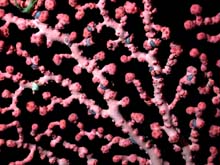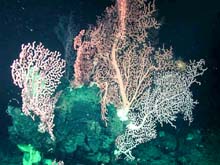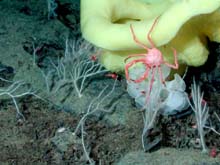A close-up of bubblegum coral (Paragorgia arborea) with small blue scale worms. Click image for larger view and image credit.
Conservation of Deep-sea Corals
Andrew DeVogelaere, PhD
Marine Scientist/Research Coordinator
Monterey Bay National Marine Sanctuary
Allen H. Andrews
Research Associate
Moss Landing Marine Laboratories
Fragile and important
Deep-sea corals are beautiful, long-lived, and fragile. They have been identified as an untapped resource with potential for generating drugs to treat cancer, natural pesticides, nutritional supplements, and other valuable things. In some cases, these corals provide habitats for commercial fishes. But the value of the deep-sea habitat created by corals should also be considered important from a perspective unrelated to benefits to humans. Particularly because of their fragility and age, deep-sea corals should be protected for world heritage, the environment we hand down from one generation to the next. Once disturbed or removed, many of these corals and the valuable habitat they create will not recover within our lifetime. It is essential that these coral habitats, especially those that have not been impacted, be identified, conserved, and studied in more detail before irreversible damage occurs.
Bubblegum corals (Paragorgia arborea) measuring 2.5 m (8 ft) in height were not uncommon at the crest of the Davidson Seamount, shown here at 1,257 m depth. Click image for larger view and image credit.
What impacts deep-sea corals?
Human activities below the ocean surface are largely unnoticed, but the destruction of deep-sea corals is clearly documented. While many types of fishing are sustainable and important as sources of food, dragging nets along the bottom in areas of deep-sea corals is increasingly being regulated. Unfortunately, we do not yet know where all the corals are located, and one pass of a net in the wrong area can create serious, long-term damage. Other human activities that can damage corals include oil and mineral exploration; cable and pipeline placement; ocean dumping; and various forms of collecting.
On the global scale, we are increasingly interested in the effects of carbon dioxide (CO2 ) in the deep sea. Global warming and the prospect of disposing "greenhouse gases" in the ocean are of interest to deep-sea biologists. Because many corals have a skeleton made of calcium carbonate, their growth would likely decrease with more CO2 dissolving in the ocean. Exact impacts are unknown, and important research on the topic is ongoing at Monterey Bay Aquarium Research Institute ![]() .
.
A red vermillion crab (Paralomis verrilli) dangles from a yellow sponge, amidst a white sponge, white coral, shrimp, brittle stars, and an isopod on the Davidson Seamount at 1,360 m depth. Click image for larger view and image credit.
Including Davidson Seamount in the Sanctuary
The National Marine Sanctuary Program is charged with understanding and protecting ocean areas of national significance. After a 2002 expedition to the Davidson Seamount, and partly because of the corals found there, the public and government advisors suggested that this seamount should be included as part of the Monterey Bay National Marine Sanctuary. Among other benefits, this would provide a government agency the opportunity to develop education programs on seamounts and deep-sea corals, as well as to improve management of this spectacular ocean environment (click here to download a fact sheet on Davidson Seamount).























